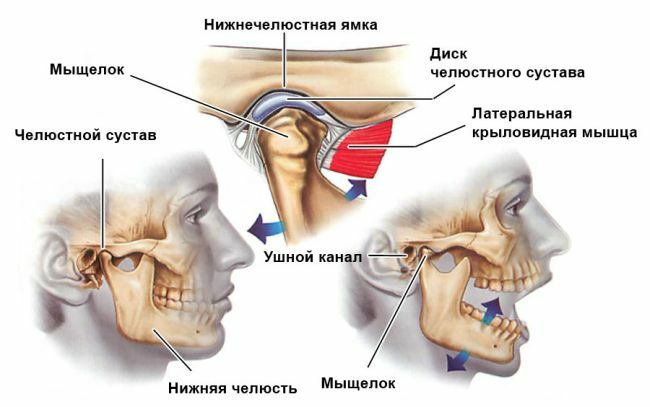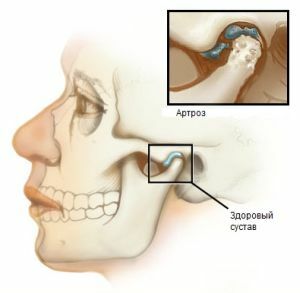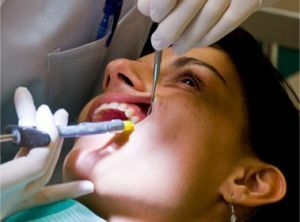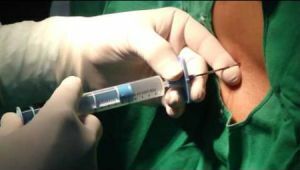 The temporomandibular joint performs in the body one of the most important functions - thanks to it, chewing movements are realized. This joint also participates in the process of speech formation.
The temporomandibular joint performs in the body one of the most important functions - thanks to it, chewing movements are realized. This joint also participates in the process of speech formation.
The joint is formed by two bones: the lower jaw and the temporal bone.
On the lower jaw there is a special protrusion, which is called the head. The head forms one side of the joint.
In the part of the temporal bone, which is located next to the lower jaw, there is a special cavity. It is called the mandibular fossa and in shape approaches the head of the lower jaw.
These two formations form the temporomandibular joint, in which the joint disc is also located.
Article Contents
- development of the disease
- Varieties
- disease Causes
- Clinical picture
- Phased signs of disease
- diagnosis in a medical institution
- methods and goals of treatment
- Grandma's recipes
- joint functions recovery
- Preventive measures
disease development
Osteoarthritis of the temporomandibular joint(TMJ) is a disease in which this joint or part of it is destroyed.
A distinctive feature of this condition is that the joint is destroyed in the absence of an inflammatory process in it.
With the development of destructive processes, there is a deformation of one of the articular surfaces or an articular disc. In this case, the joint begins to collapse and changes its shape.
When the disease progresses, bone may be involved in the process of destruction.
So, as the joint changes its shape, the angle under which it is located in the bones of the facial skeleton also changes. This leads to a disruption of joint function.

In arthrosis, normal joint tissue can be replaced by a dense fibrous connective tissue that grows and engages the articular disc. As a result of this process, the joint can not perform its normal movements, which leads to a deterioration of the conversational and chewing functions.
Types of the disease
There are two types of arthrosis of the temporomandibular facial joint:
- sclerosing - the joint remains practically unchanged, but it loses its mobility, which significantly limits movement in it;
- deforming - deformation occurs due to the process of proliferation of connective tissue, resulting in the joint also losing its mobility.
Causes of the disease
Allocate common and local causes of the development of destructive processes.
Common causes include: 
- endocrine pathology;
- neurocirculatory diseases;
- pathology of the cardiovascular system;
- muscular dystrophy;
- osteoporosis;
- metabolic disorders;
- infectious diseases.
For local reasons, the following pathologies are attributed:
- traumatic joint damage( regardless of the time of injury and the development of the disease);
- arthritis;
- excessive load on the lower jaw;
- anatomical features of the structure of the vessels of the head;
- bruxism;
- no teeth;
- pathological untreated deformation of lateral molars.
In case of traumatic joint injury, the sclerosing appearance of the TMJ arthrosis most often develops.
In the presence of osteoporosis, arthritis, arthroarthrosis, in most cases, changes in the deforming type are observed.
Features of the clinical picture
The main symptom of the presence of arthrosis of the jaw joint is violation of the masticatory function of .
In this case, it is difficult for a person to open their mouths, or open their mouths completely. This process can be accompanied by pain syndrome or discomfort phenomena.
There may also be difficulties in making a certain type of food - a piece of bread, apple, meat. This is related to the width of the product. To bite off a piece of such food, a person needs to open his mouth wide enough.
People with arthrosis of the maxillofacial joint either can not do this in sufficient volume, or this process is accompanied by pronounced discomfort sensations.
Also, people with changes in the temporomandibular joint may experience pain or discomfort in the process of chewing food.
In some cases, the discomfort is insignificant, however, the noise and clicks that the person hears when the joint works come to the fore of the disease.
Phased development of
 As a rule, the disease begins with a feeling of discomfort in those cases when a person needs to open his mouth wide.
As a rule, the disease begins with a feeling of discomfort in those cases when a person needs to open his mouth wide.
Then, the sounds of clicks can be added during joint operation and painful sensations. The next stage is the appearance of pain and discomfort in the normal opening of the mouth.
Then develop unpleasant sensations when chewing food and during a conversation. Over time, the distance to which a person can open the mouth decreases. The work of the lower jaw without feeling discomfort or pain in such cases is impossible.
Symptoms of acute or chronic forms of the disease depend on the time that elapses between the appearance of the first symptom and the almost complete inability to open normally the mouth.
If the process develops within 3 months, doctors diagnose acute arthrosis of the TMJ.If the process develops within half a year, it is considered a subacute course of the disease. With the development of the process for more than 6 months, a diagnosis of the chronic form of the disease should be made.
Diagnosis in a medical institution
Diagnosis of the disease is carried out according to the clinical picture and instrumental methods of treatment.
Instrumental methods include:
- three-dimensional joint radiography;
- SPL;
- MRI;
- CT.
The best results of the study are given by the methods of MRI and three-dimensional X-ray diagnostics.
Methods and objectives of treatment
The main goal of treatment is to slow down the process of joint destruction and improve its function.
In the acute period, the priority is precisely the stopping of the destruction of the temporomandibular joint. In the chronic period, priority is given to restoring the function of the altered joint.
Treatment of arthrosis of the temporomandibular joint is divided into: medicamentous and non-medicamentous. 
As a drug treatment, chondroprotectors are used, drugs that improve blood circulation, vitamin therapy.
Non-pharmacological methods include:
- adherence to a diet rich in vitamins, recommend the use of small foods to moderate loading of the joint;
- physical exercise;
- physiotherapy;
- therapy with various currents.
Grandmother's recipes
For the treatment of arthrosis of the maxillofacial joint, prescriptions of traditional medicine are often used.
The folk methods include:
- rinse with chamomile broth;
- rinsing decoction motherwort;
- gauze applications of chamomile broth in the projection of the affected joint for 5 minutes 3 times a day;
- lubrication of the temporomandibular joint area with sea buckthorn oil to improve blood circulation in the joint.
Restoration of joint functions
 Full recovery of joint function with its arthrosis is impossible. However, you can significantly improve the performance of its functions.
Full recovery of joint function with its arthrosis is impossible. However, you can significantly improve the performance of its functions.
For this purpose it is necessary to attend physiotherapeutic procedures and daily to do gymnastics. Gymnastics consists of alternately opening, closing the mouth, pushing forward and sideways of the lower jaw.
Such exercises must be performed for three minutes 7-9 times a day, daily.
If the arthrosis of the temporomandibular joint is not treated, its full ankylosis can develop - immobility in the joint, which will lead to the inability to eat and talk.
Preventive measures
There is no specific prevention of the disease.
However, there are simple recommendations, the implementation of which can reduce the likelihood of developing this pathology. These include:
- annual preventive visit to a dentist;

- timely treatment of acute diseases;
- high-grade therapy of chronic diseases;
- a balanced diet.
Osteoarthritis of the temporomandibular joint can develop in people of any age. To reduce the likelihood of developing this disease, it is necessary to fully implement the recommendations for prevention.
Early diagnosis is the key to successful treatment and almost complete restoration of the function of the damaged joint.



